Are you eager to learn How To Get Paid For Your Photos and transform your passion into a profitable venture? At dfphoto.net, we understand that every photographer dreams of monetizing their skills, whether it’s through stock photography or capturing the beauty of visual arts. Let’s explore the most effective strategies to turn your stunning images into income streams. This comprehensive guide will provide you with insights and actionable tips to succeed in the competitive world of photography.
1. Exploring the Best Platforms To Sell Photos Online
Are you wondering where the best places are to sell your photographs online? Many platforms cater to different styles and niches.
1.1 Alamy: The Diverse Stock Photo Marketplace
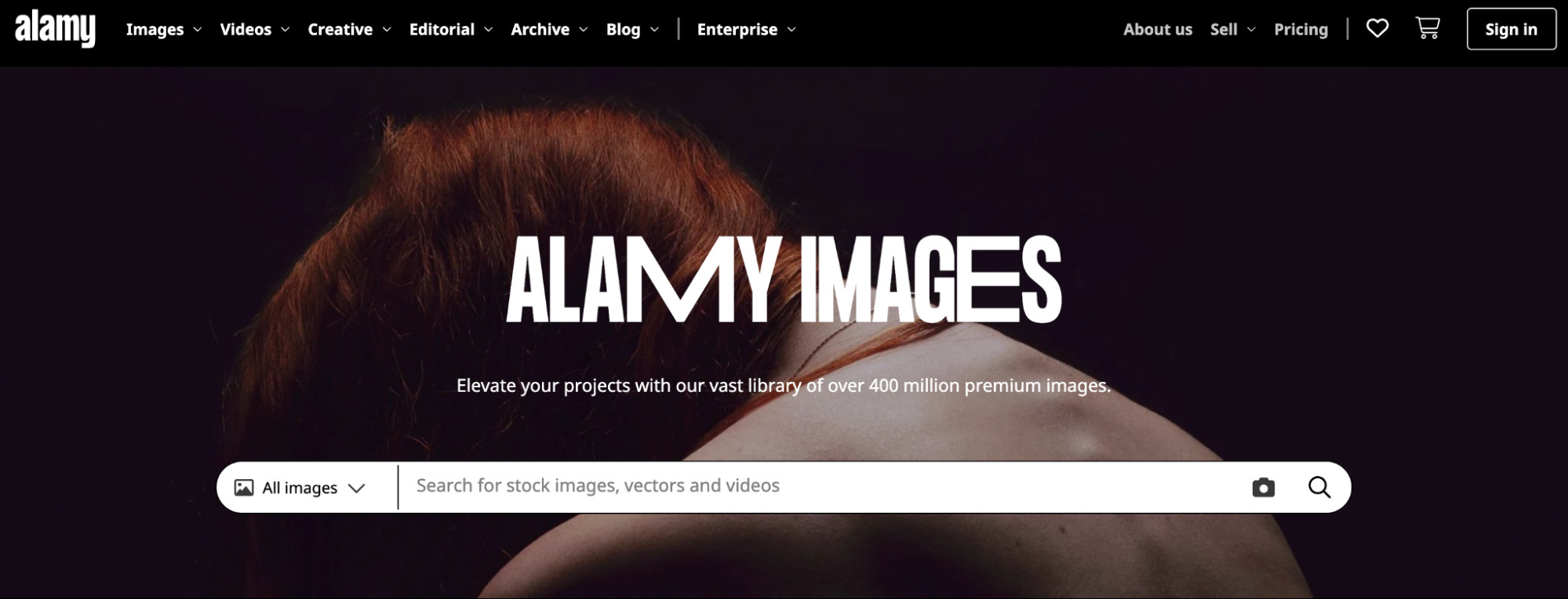 Alamy Images homepage showing a search bar for people to find royalty-free images.
Alamy Images homepage showing a search bar for people to find royalty-free images.
Do you want a platform with a wide range of stock images? Alamy stands out with its extensive collection of stock photos, vectors, videos, and 360-degree panoramic images. Contributing to Alamy can be highly rewarding due to its diverse content needs and global reach. You can even use their iOS app, Stockimo, to sell photos directly from your smartphone.
1.1.1 How to Get Paid on Alamy
How does Alamy pay its contributors? Alamy offers monthly payments with commission models that range from 17% to 50% of sales, depending on the popularity of your images and the type of license. The platform doesn’t require long-term contracts, and you have the flexibility to receive payments in multiple currencies.
1.2 500px: Combining Licensing With Community
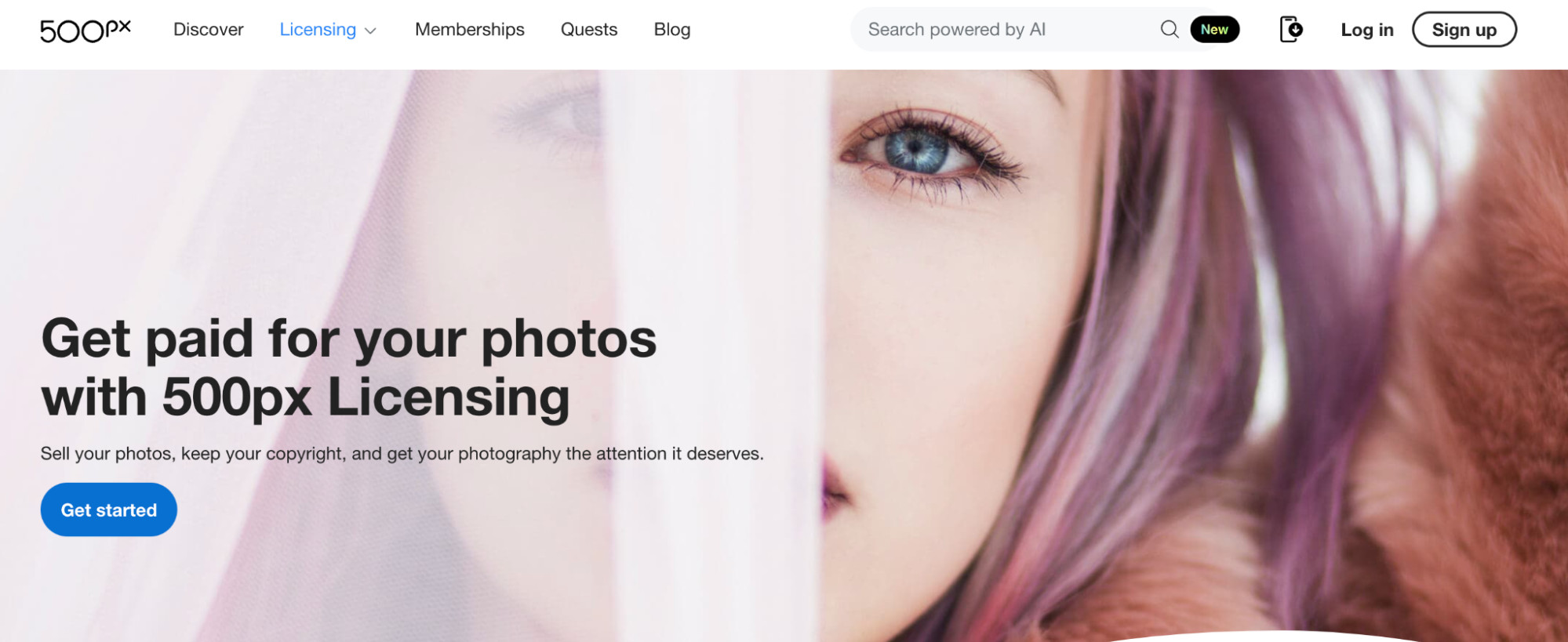 500px’s homepage that shows how contributors can get paid for their photos with licensing.
500px’s homepage that shows how contributors can get paid for their photos with licensing.
Do you value community and licensing opportunities? 500px combines stock photo licensing with community features, providing a platform for both amateur and professional photographers. Its Pulse algorithm highlights emerging talents, making it easier for new photographers to gain recognition, provided their photos meet the platform’s quality standards.
1.2.1 How to Get Paid on 500px
How much can you earn on 500px? Paying members can earn up to 100% royalties for exclusive photos, making it a lucrative option for those dedicated to the platform.
1.3 Shutterstock: The Popular Micro-Stock Site
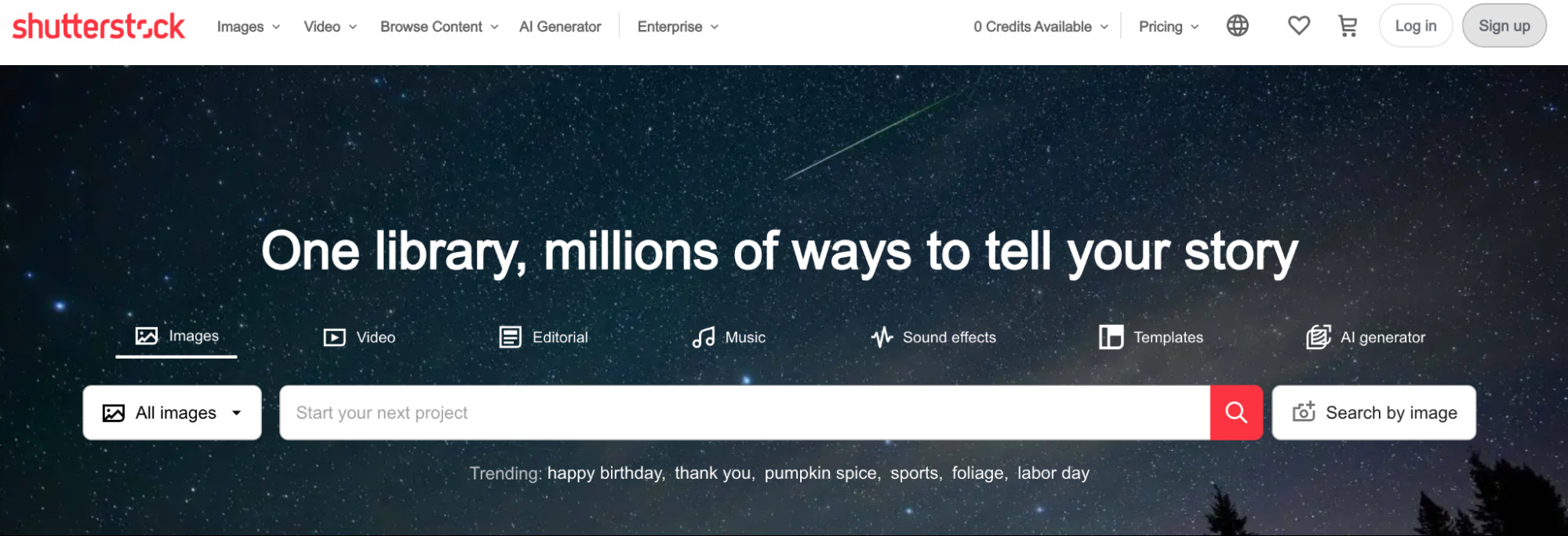 Shutterstock homepage that lets people find royalty-free images, video, and music.
Shutterstock homepage that lets people find royalty-free images, video, and music.
Looking for a well-known platform with high volume? Shutterstock is one of the most popular stock photography websites, having paid out over $1 billion to its community in the past 15 years. It operates as a micro-stock site, where photos are cheaper and non-exclusive, making it a great starting point for learning how to sell stock photos.
1.3.1 How to Get Paid on Shutterstock
How does Shutterstock compensate its contributors? Payouts are based on earnings over time, ranging from 15% to 40%. Additionally, Shutterstock offers an affiliate program where you can earn extra money by referring new photographers or customers.
1.4 Getty Images: The Premium Stock Photo Library
 Getty Images’ homepage with a search bar that helps people find photos and images.
Getty Images’ homepage with a search bar that helps people find photos and images.
Do you aim for high-quality, exclusive images? Getty Images attracts brands and online publishers looking for premium, hard-to-find images. The platform, along with its microstock site, iStock, reaches over 1.5 million customers worldwide. Due to its high standards, selling on Getty Images is more competitive.
1.4.1 How to Get Paid on Getty Images
How can you become a Getty Images contributor? You need to apply with a set of sample photos. Once accepted, you can earn between 15% and 45% of an image’s license fee.
1.5 iStock: The Non-Exclusive Getty Alternative
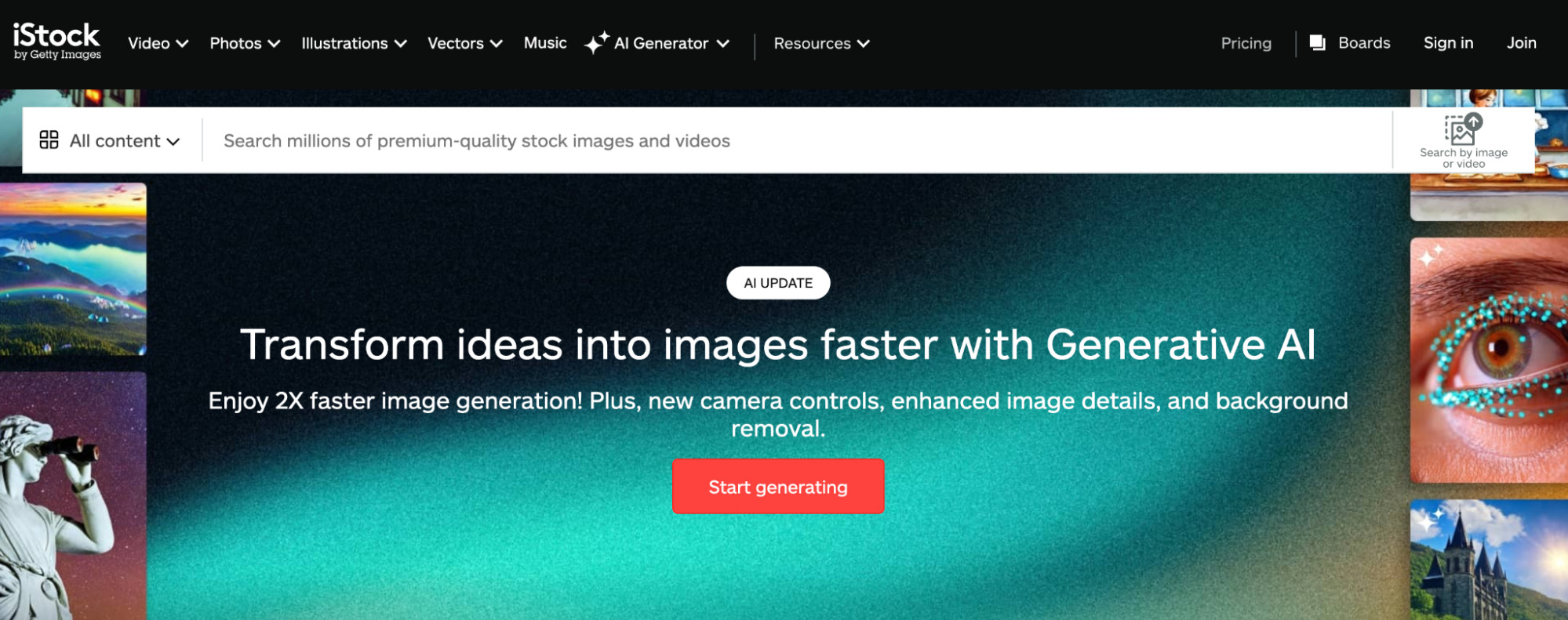 Landing page for iStock that shows its generative AI-powered image creator.
Landing page for iStock that shows its generative AI-powered image creator.
Seeking a more flexible platform similar to Getty? iStock is an offshoot of Getty Images that allows non-exclusive photos. This means you can sell your photography on other agencies as well.
1.5.1 How to Get Paid on iStock
What are the commission rates on iStock? To sell your photos on iStock, you need to apply with sample images. Commissions range from 15% to 45%, depending on the contributor agreement.
1.6 Stocksy: The Artist-Owned Cooperative
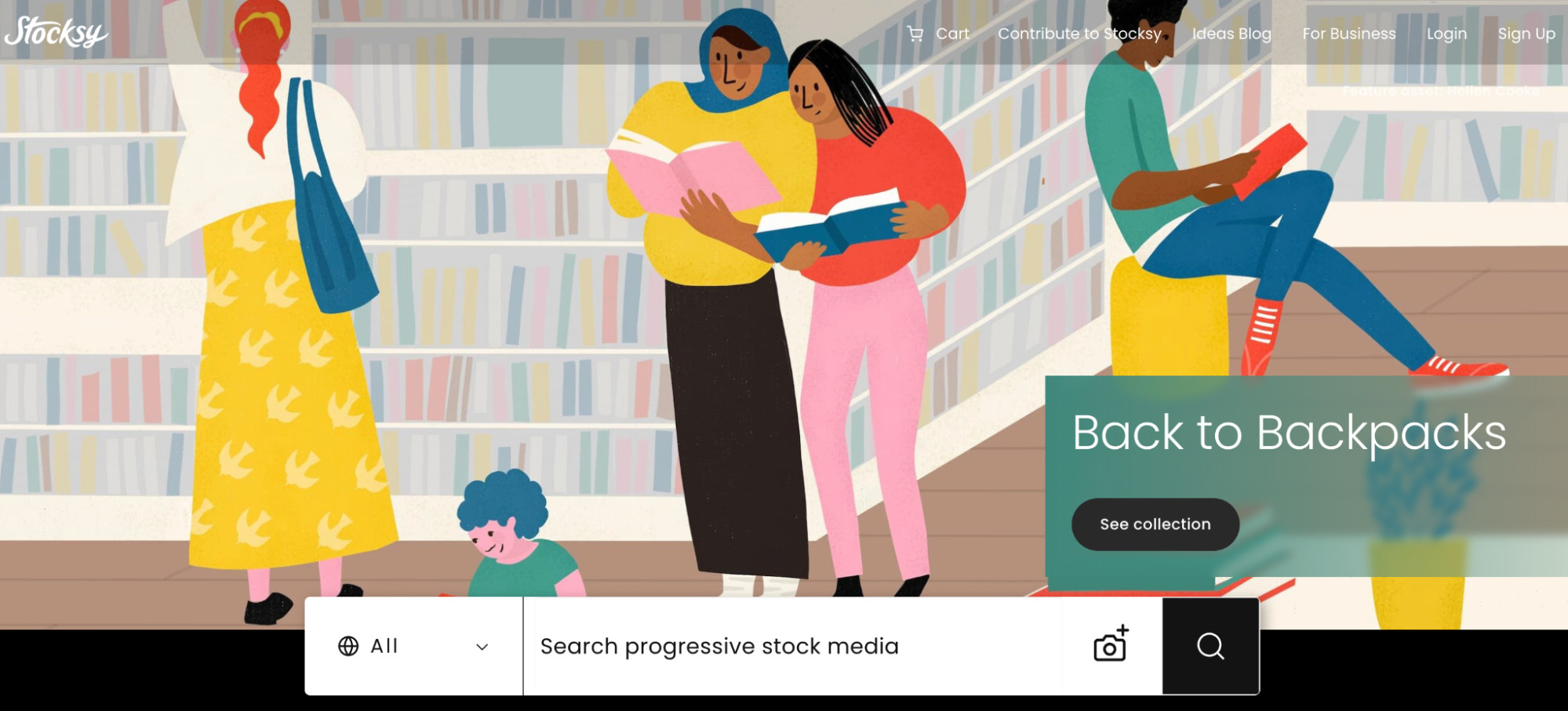 Stocksy homepage with an art graphic of people in a library.
Stocksy homepage with an art graphic of people in a library.
Interested in a platform that values its contributors? Stocksy is an artist-owned cooperative known for its high payouts. Photographers earn a 50% royalty on standard licenses and a 75% royalty on extended licenses. All photos must be exclusive to the platform.
1.6.1 How to Get Paid on Stocksy
How does Stocksy compensate its contributors? Stocksy contributors are paid monthly via PayPal, Payoneer, or check, with a minimum payout of $100. The platform also offers profit-sharing in the form of patronage returns when the co-op has a surplus.
1.7 Picfair: Creating Your Own Photography Ecommerce Website
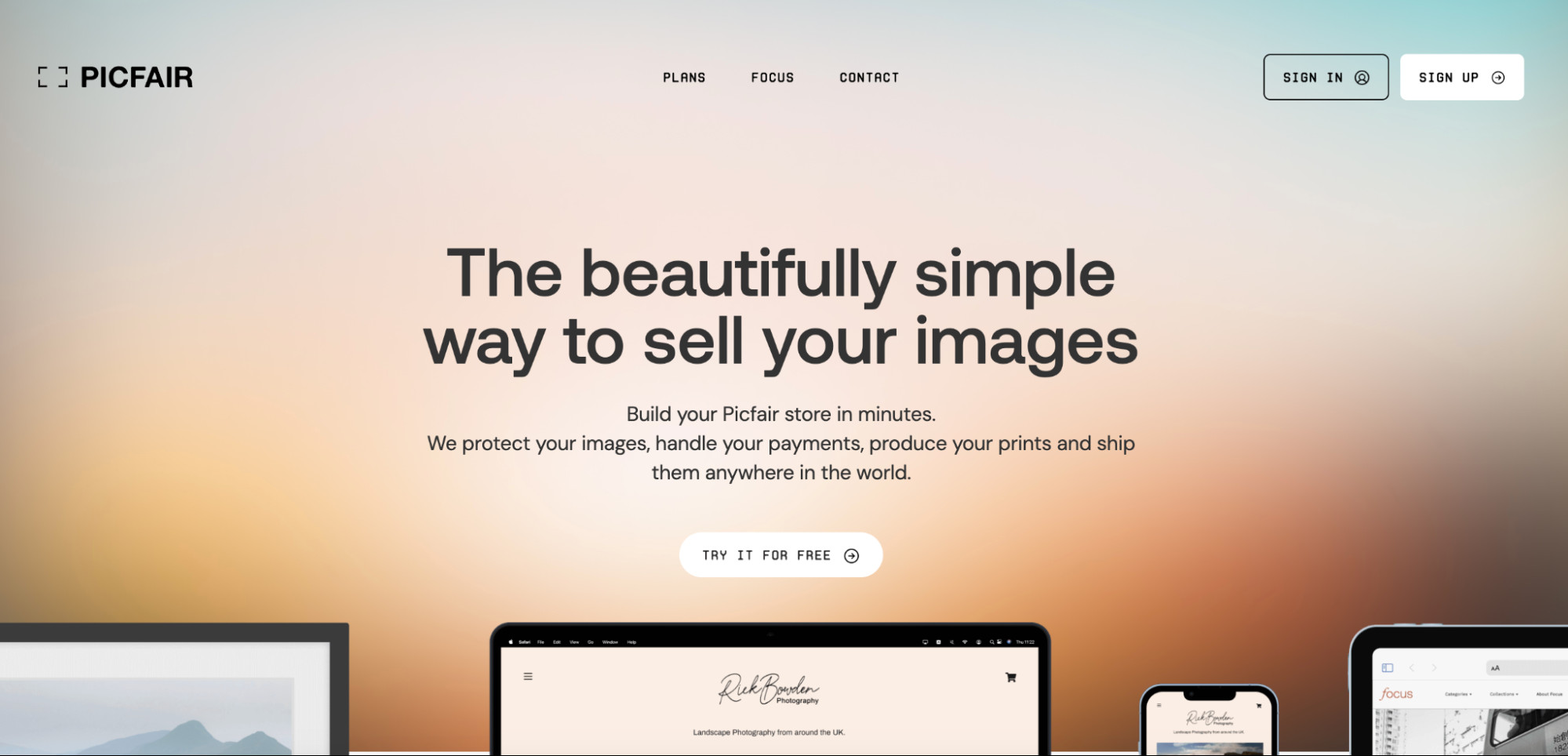 Picfair landing page for a website builder built for photographers.
Picfair landing page for a website builder built for photographers.
Do you want more control over your online presence? Picfair allows you to create your own photography e-commerce website, giving you control over pricing for both prints and digital downloads. Picfair handles payment processing, print production, shipping, and licenses for digital images.
1.7.1 How to Get Paid on Picfair
How can you start selling on Picfair? Sign up for a Plus plan, priced at $4 per month when billed annually. This allows you to create a custom Picfair store with up to 10,000 images that can be sold as prints or downloads.
1.8 Adobe Stock: Integration With Adobe Software
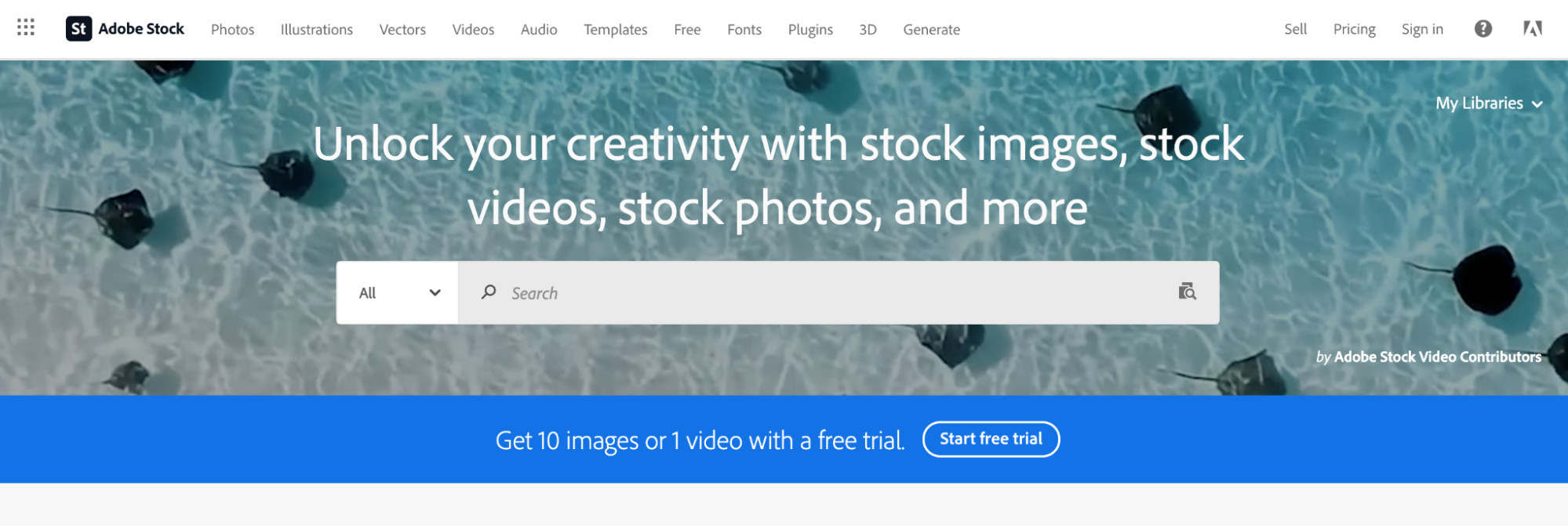 Adobe Stock homepage showing a search bar against a photo of sting rays in the ocean.
Adobe Stock homepage showing a search bar against a photo of sting rays in the ocean.
Are you an Adobe Creative Suite user? Adobe Stock integrates seamlessly with popular photography software like Lightroom and Bridge. You can add your images, videos, vectors, and illustrations directly to the platform.
1.8.1 How to Get Paid on Adobe Stock
What are the royalty rates on Adobe Stock? Contributors who link their Adobe ID to Adobe Stock can earn 33% royalties on photos and 35% on videos.
1.9 Envato Elements: Sharing Subscriber Revenue
 Landing page for stock photos on Envato Market.
Landing page for stock photos on Envato Market.
Seeking a platform that shares subscription revenue? Envato Elements allows you to sell photos and connect with potential clients. You can sell photos on their app or upload them to your own site on the brand’s domain.
1.9.1 How to Get Paid on Envato Elements
How does Envato Elements compensate contributors? Contributors earn between 25% and 50% of net subscription revenue.
1.10 Unsplash+: Getting Paid for Assignments
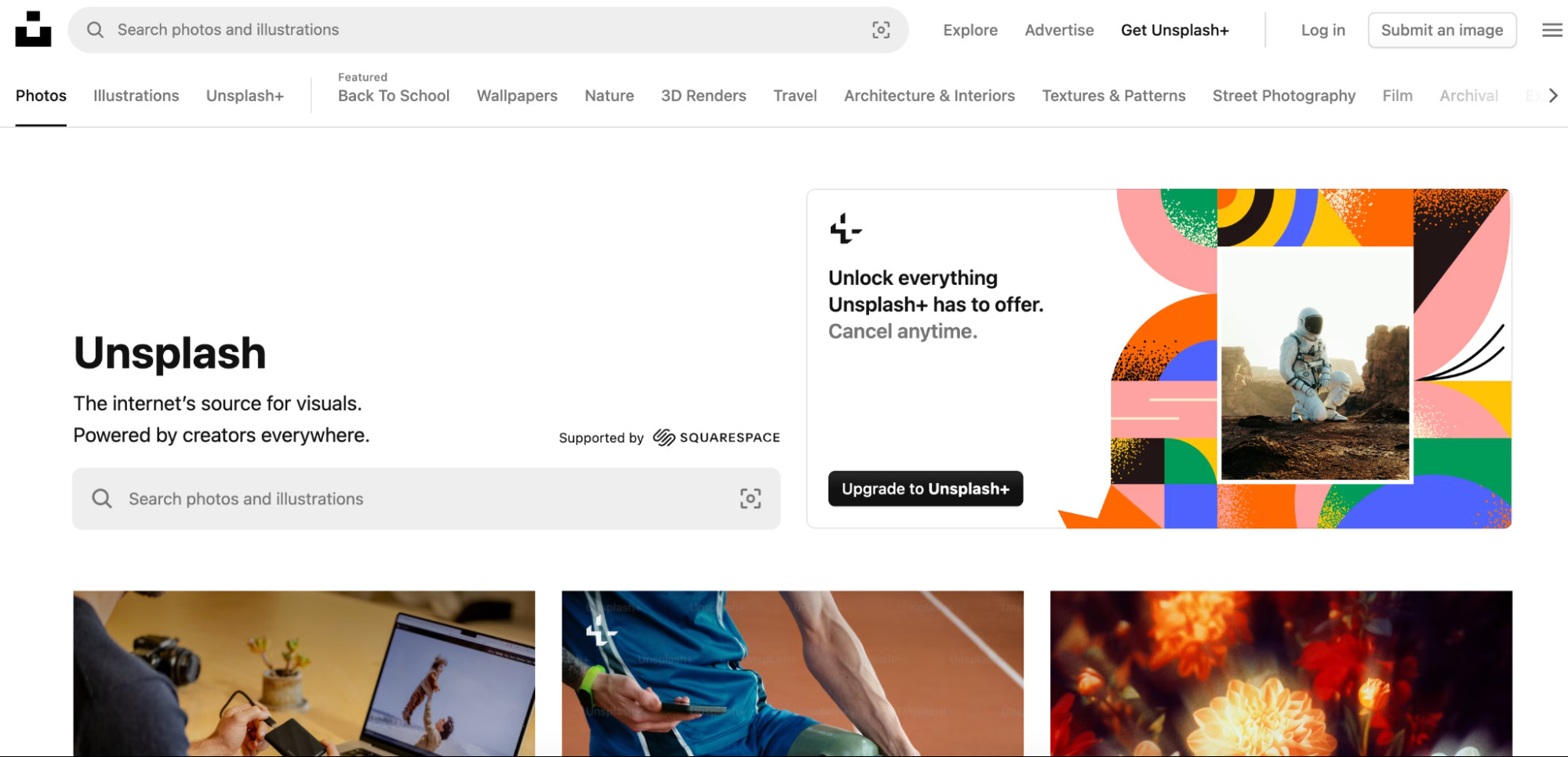 Unsplash homepage showing stock photos and a call-to-action for Unsplash
Unsplash homepage showing stock photos and a call-to-action for Unsplash
Interested in assignment-based payments? Unsplash, owned by Getty, pays photographers for submitting images for specific briefs and requests through its Unsplash+ program.
1.10.1 How to Get Paid on Unsplash+
How can you participate in Unsplash+? Once accepted into the program, you can choose briefs that match your skills, upload your photos, and get paid for each accepted image. Rates range from $5 to $30 per image.
1.11 Dreamstime: The Microstock Library
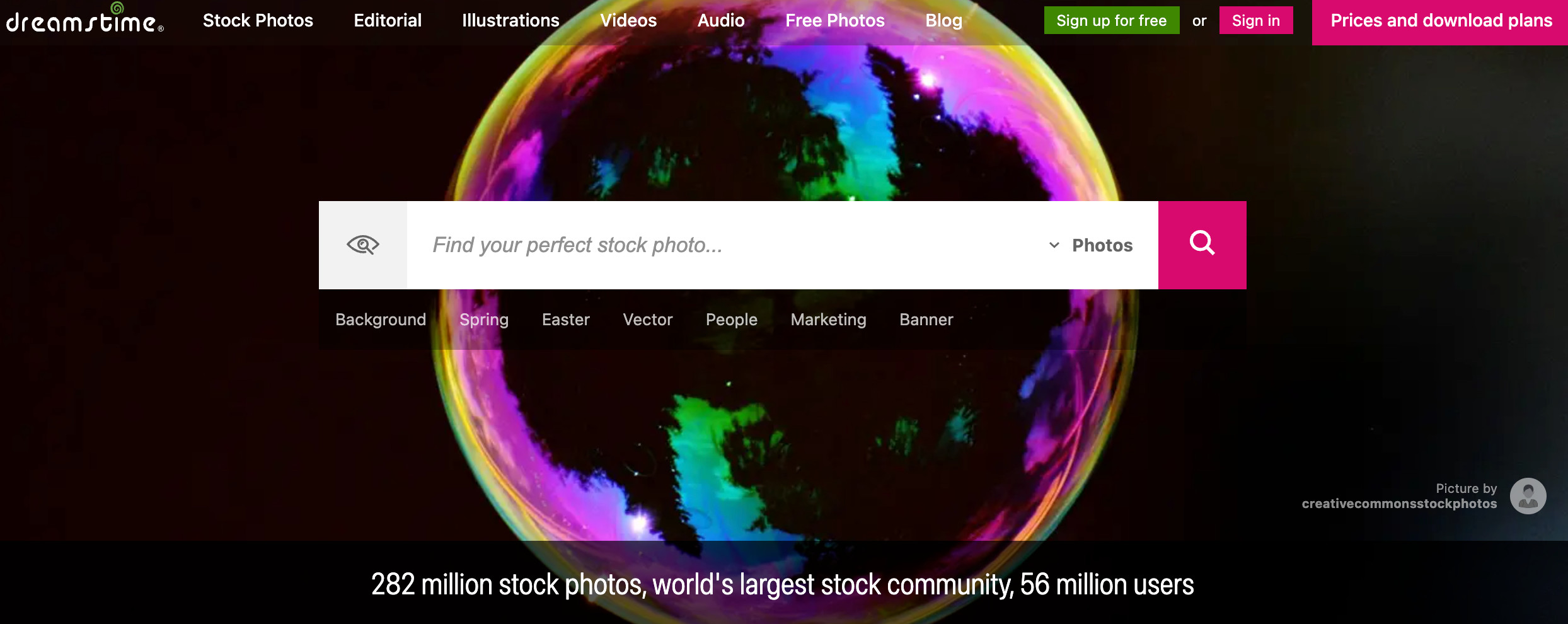 Dreamtime homepage where you can sell photos
Dreamtime homepage where you can sell photos
Looking for a platform with a massive library? Dreamstime features over 250 million files and a user base of over 50 million, providing photographers with access to a large, active audience.
1.11.1 How to Get Paid on Dreamstime
What is the revenue sharing model on Dreamstime? Dreamstime offers revenue sharing of 25% to 50% for non-exclusive content. Exclusive contributors earn an additional 10% and receive 20¢ for each approved submission. The platform also has an affiliate program that pays 10% of transaction values for each referred contributor or customer.
1.12 Snapped4U: For Event and Portrait Photographers
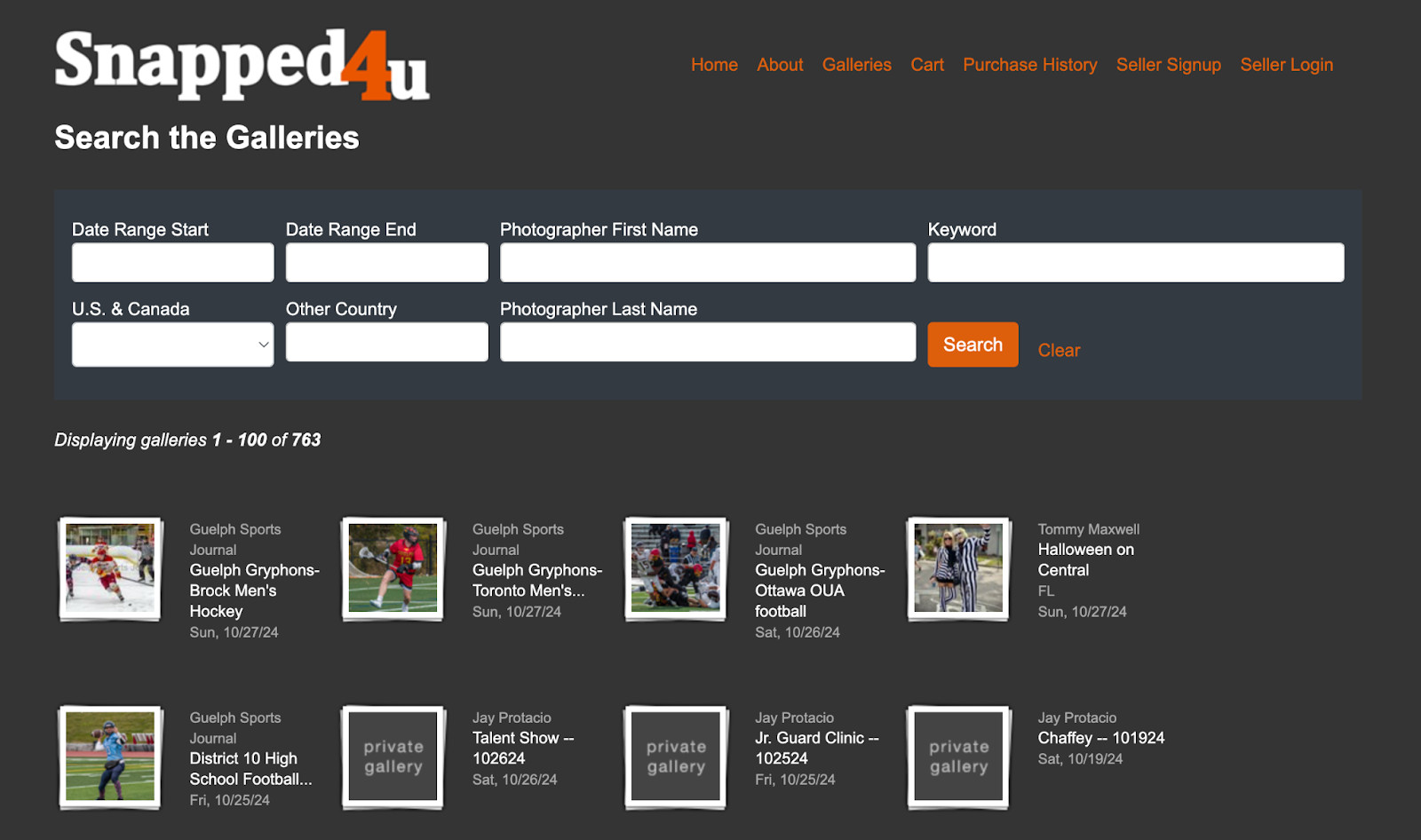 Snapped4U homepage showing photos from sports photographers
Snapped4U homepage showing photos from sports photographers
Are you specialized in event and portrait photography? Snapped4U is a marketplace designed specifically for photographers in these niches, allowing you to create personalized galleries and sell digital files directly to clients.
1.12.1 How to Get Paid on Snapped4U
How does Snapped4U handle payments and commissions? Snapped4U charges a one-time $10 registration fee and retains a 10% to 12% commission on sales. Photographers are paid the balance in their account via PayPal on the 1st and 15th of each month.
1.13 Foap: Selling Directly to Brands
 Foap creator landing page advertises a mobile app for photographers
Foap creator landing page advertises a mobile app for photographers
Want to sell your photos directly to brands? Foap allows photographers to sell commercial-quality images directly to brands and individuals through “missions” and its marketplace.
1.13.1 How to Get Paid on Foap
What are the payment options on Foap? Mission payouts range from $100 to $2,000. For individual photos sold on the Foap market, Foap takes a 50% commission on all sales.
1.14 EyeEm: Combining Community With Marketplace
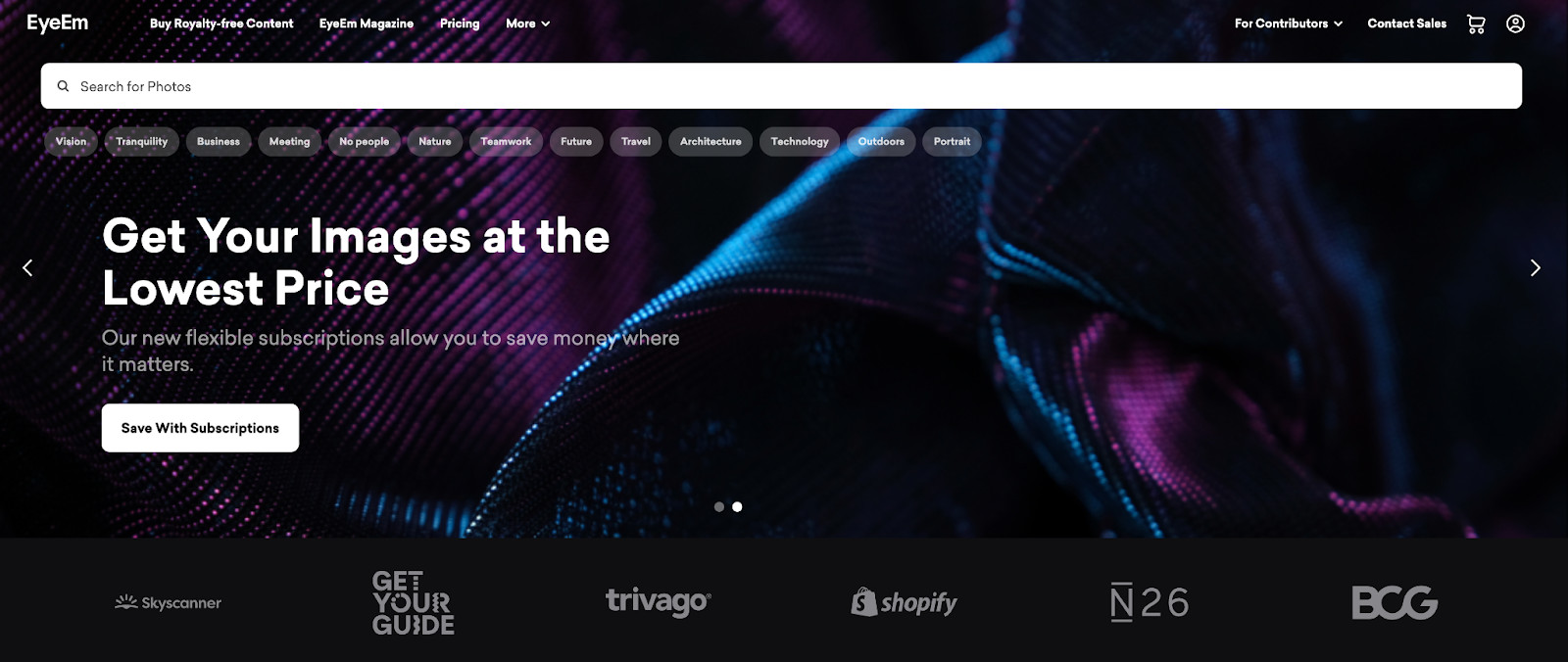 EyeEm homepage with a search bar and examples of high-profile clients
EyeEm homepage with a search bar and examples of high-profile clients
Looking for a platform with a strong community aspect? EyeEm combines a marketplace with a photographer community, inviting photographers to contribute to missions that call for images on specific themes.
1.14.1 How to Get Paid on EyeEm
How much commission can you earn on EyeEm? Contributors earn a 50% commission on each sale made through the EyeEm marketplace. Payments are made via PayPal.
1.15 Pond5: For Video Content
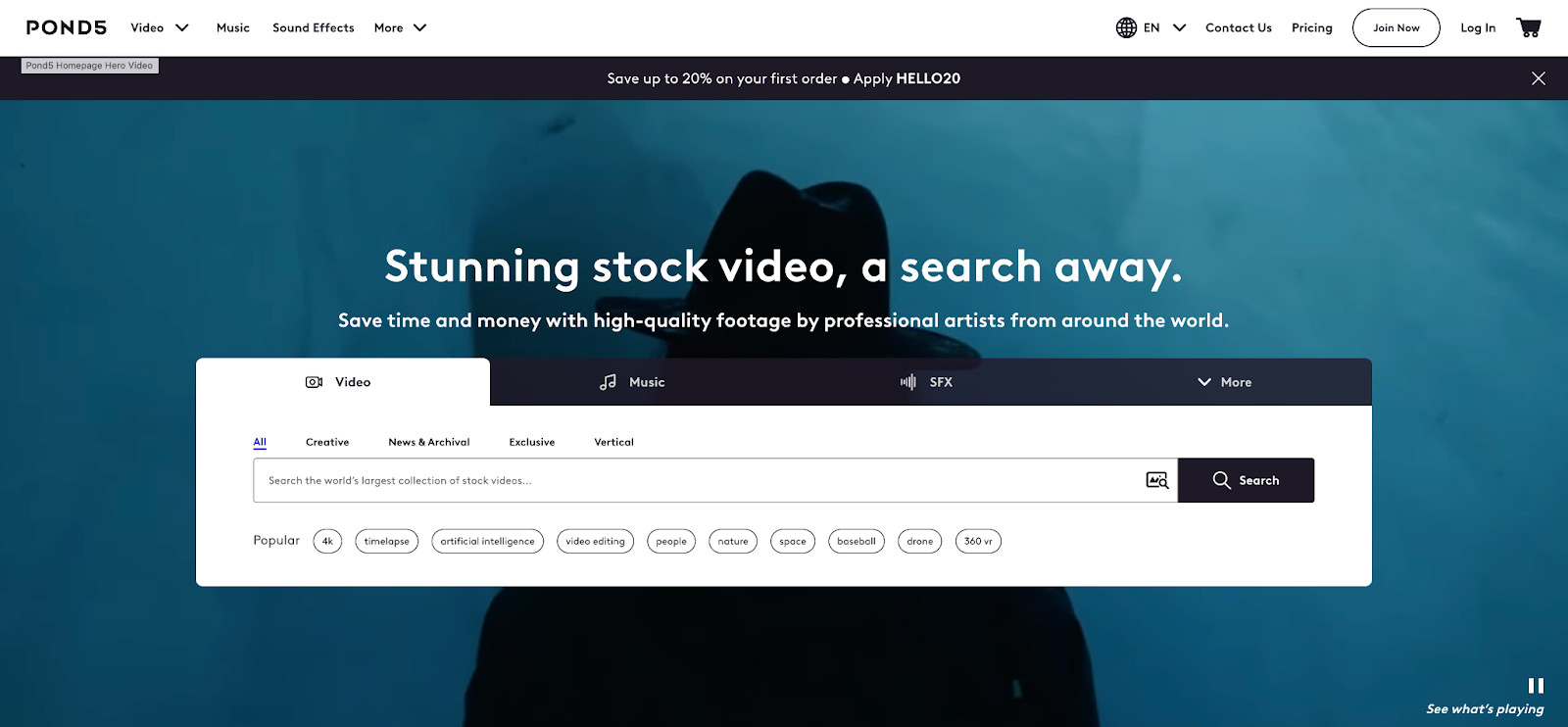 Pond5
Pond5
Do you specialize in video content? Pond5 is a marketplace for selling royalty-free videos, music, sound effects, and other assets. It caters to major brands like BBC and Disney.
1.15.1 How to Get Paid on Pond5
What are the royalty rates on Pond5? Video artists earn a 40% royalty share, with the option to make content exclusive and earn up to 60%. Pond5 also offers a referral program for additional income.
2. Tips For Selling Photos Online Successfully
Are you looking to boost your success in the stock photo market? Here’s how to enhance your strategy.
2.1 Define Your Stock Photography Niche
Do you want to stand out in the crowded stock photo market? Focus on a consistent style or theme, such as travel, fashion, nature, or food. Consistency helps build a recognizable brand and attracts a specific audience.
2.2 Leverage Instagram To Showcase Your Work
Are you using social media to its full potential? Instagram is a powerful platform for photographers to reach a wide audience. Use Instagram tools to engage with popular hashtags, follow relevant accounts, and grow a following of potential customers.
2.3 Integrate Ecommerce Into Your Website
Have you considered selling directly from your site? Adding a Shopify Buy Button to your website can make it easier for customers to purchase your stock images. This gives you more control over the sales process and customer experience.
2.4 Understand Your Market
Do you know who your ideal customer is? Identifying your target market helps you produce photos that appeal to them. For example, if you specialize in wedding photography, your target market might be wedding stationery brands or suit wholesalers.
3. How to Set Up Your Online Portfolio
Is your online portfolio optimized to attract clients? Here are essential steps to create an effective portfolio.
3.1 Choose The Right Platform For Your Needs
Which platform best aligns with your goals? The ideal platform depends on your business goals and the level of control you want over your imagery. Options range from stock photo submissions to e-commerce platforms like Shopify.
3.2 Plan Your Portfolio’s Structure For Impact
How should you structure your portfolio? A well-structured portfolio includes:
- Layout: Photos should be the focus, with context provided to enhance their appeal.
- Social Proof: Include quotes from satisfied customers or examples of successful campaigns featuring your images.
- Categories and Organization: Organize images by category, such as location, environment, subject, and date.
- Gallery Size: Only showcase your best, high-quality images.
3.3 Optimize Images For Web Performance
Are your images optimized for online viewing? Fast-loading images are crucial for user experience. Compress images without compromising quality, use descriptive file names, and add alt text for SEO.
3.4 Create An About Page That Tells Your Story
Does your About page engage potential clients? Use this page to tell your story and share your passion for photography. Explain how you got started, what you love to shoot, and where you draw inspiration from.
3.5 Implement Ecommerce Functionality
Does your site make it easy to buy your work? An e-commerce platform like Shopify handles the logistics of selling photos online, including setting up a storefront, processing payments, and managing shipping.
3.6 Ensure Mobile Compatibility For All Users
Is your site accessible on mobile devices? With more than half of global website traffic coming from mobile devices, ensure your portfolio looks great on smaller screens with a responsive website design.
3.7 Launch And Promote Your Photos Effectively
How are you promoting your work? Share your portfolio link online using marketing tactics such as reposting images on social media, pinning photos on Pinterest, gifting free prints to influencers, and documenting behind-the-scenes content on TikTok, YouTube, or Instagram Reels.
4. How To Sell Photos As Prints And Photo Books
Do you want to expand your offerings beyond digital images? Selling photos as prints and photo books can provide additional revenue streams.
4.1 Selling Photos As Physical Products
Are you offering physical products featuring your photography? Partner with a local photo lab or use a print-on-demand company to dropship a wide range of products, such as prints, phone cases, and pillows.
4.2 Creating And Selling Photo Books
Have you considered creating photo books? Photo books based around a compelling theme can be a great way to sell your art online, especially if your photography is niche and consistent.
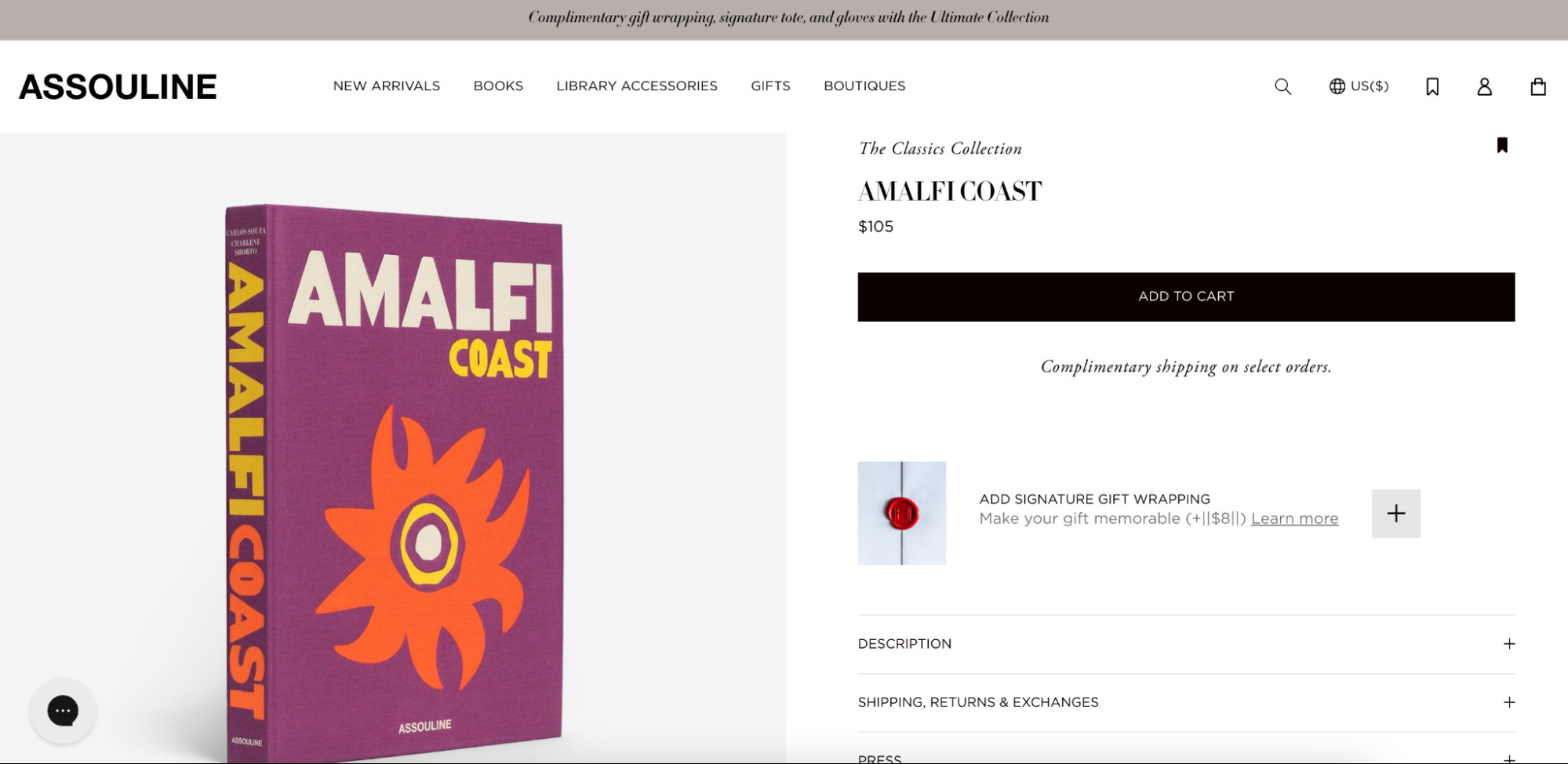 Photobook of images taken on the Amalfi Coast.
Photobook of images taken on the Amalfi Coast.
According to research from the Santa Fe University of Art and Design’s Photography Department, in July 2025, photo books are a great way to attract the high-end customers, because they are willing to spend more money on higher quality photography, so get right on it.
5. How To Sell Your Photography Services
Are you looking to offer your services directly to clients? Here are networking tips to help you succeed.
5.1 Networking Tips For Photographers
How can you build your network and attract clients? Here are essential networking strategies:
- Always Have Business Cards: Use Shopify’s free business card generator to create your own.
- Optimize Your LinkedIn Profile: Showcase your work and optimize your profile for your main photography service.
- Attend Networking Events: Focus on events where entrepreneurs and event organizers are present.
- Build a Personal Brand: Regularly share your work on social media platforms to stay top of mind.
5.2 Utilizing Booking Platforms For Time Management
Are you efficiently managing your time? Use booking platforms like Setmore or SimplyBook.me to allow clients to see your availability and book you directly. If you’re using Shopify, add a scheduling app to book appointments directly from your site.
6. Pricing Strategy For Selling Photos Online
How do you determine the right price for your photos? Here’s a guide to developing an effective pricing strategy.
6.1 Key Considerations For Pricing
What factors should influence your pricing decisions? Consider these elements:
- Market Research: Research how much comparable photos sell for on stock image sites.
- Profit Margins: Account for the costs of photography, such as equipment, website hosting fees, and marketing budgets.
- Usage Rights: Set different prices for exclusive and non-exclusive photos.
- Discounts and Promotions: Experiment with discounts and promotions to incentivize purchases.
- Product Bundles: Offer collections of related images at a discounted price.
7. Legal Primer For Selling Your Photos Online
Are you familiar with the legal aspects of selling photos online? Here’s what you need to know to protect yourself.
7.1 Glossary Of Legal Terms
What are the key legal terms to understand? Here are some essential definitions:
- Editorial Use: Permission to use in blogs, newspapers, and magazines.
- Commercial Use: Permission to use in marketing and advertising.
- Retail Use: Permission to use in the creation of physical products for sale.
- Exclusive Use: The buyer is the only one who can use the photo.
- Non-Exclusive Use: Photo licenses can be purchased and used by anyone.
- Public Domain: Photos with no restrictions or copyright claims.
- Creative Commons: Conditional usage allowed, with attribution sometimes required.
- Royalty-Free: Others can buy a license and use the photo an unlimited number of times.
- Rights Managed: A one-time license with restrictions regarding distribution.
- Right of Publicity: Subjects in your photos have rights regarding their inclusion, especially for commercial use.
7.2 Steps To Take If Your Photos Are Stolen
What should you do if someone steals your photos? Watermark your digital images, send a cease and desist request, or invoice the culprit for using your photo. Always try to get credit for your work, even for editorial purposes.
8. Final Thoughts
Mastering how to get paid for your photos involves understanding the market, creating high-quality content, and protecting your work. By following these strategies and leveraging the resources available at dfphoto.net, you can transform your passion for photography into a sustainable income source. Remember, the journey of a thousand miles begins with a single step. Start today and capture your financial freedom through photography. According to Popular Photography, mastering your craft is the key.
Ready to take your photography to the next level?
Visit dfphoto.net today for more tips, tutorials, and resources to help you succeed in the world of photography! Explore our extensive collection of stunning images, connect with a vibrant community of photographers, and discover new ways to elevate your skills.
9. Contact Information
For further inquiries and assistance, you can reach us at:
- Address: 1600 St Michael’s Dr, Santa Fe, NM 87505, United States
- Phone: +1 (505) 471-6001
- Website: dfphoto.net
10. How To Sell Photos Online FAQ
10.1 What Is The Best Way To Sell Photographs?
The best way to sell photographs online is often by selling them as stock images on third-party websites like iStock, Shutterstock, or Alamy. These platforms provide a quick, easy, and affordable way to reach a broad audience.
10.2 Where Can I Sell My Photos Online For Money?
You can sell your photos online for money on various platforms, including:
- Alamy
- 500px
- Shutterstock
- Getty Images
- iStock
- Stocksy
- Picfair
- Adobe Stock
- Envato Elements
- Unsplash+
- Dreamstime
- Snapped4U
- Foap
- EyeEm
- Pond5 (for videos)
10.3 How Do You Make Money From Stock Photography?
A stock photography website, or stock agency, sells high-priced and exclusive images that you upload. The agency licenses individual images to clients and sells them for a set price. You, the photographer, then receive a royalty payment based on the licensing fee.
10.4 What Should I Consider When Choosing A Platform To Sell My Photos?
When selecting a platform, consider factors such as commission rates, exclusivity requirements, target audience, and ease of use. Some platforms offer higher royalties but require exclusivity, while others provide broader exposure but lower payouts.
10.5 How Can I Protect My Copyright When Selling Photos Online?
To protect your copyright, watermark your images, use clear licensing agreements, and monitor for unauthorized use of your photos. If you find your photos being used without permission, take legal action, such as sending a cease and desist letter.
10.6 What Are Some Essential Tips For Building A Successful Photography Portfolio?
Essential tips include showcasing your best work, organizing your photos into categories, optimizing images for web performance, and creating an engaging “About” page to connect with potential clients.
10.7 How Important Is Niche Selection In Stock Photography?
Niche selection is crucial because it helps you target a specific audience and stand out in a crowded market. Focusing on a consistent style or theme, such as travel or food, can attract buyers looking for specific types of images.
10.8 What Are The Best Strategies For Promoting My Photography Online?
Effective strategies include using social media platforms like Instagram, integrating e-commerce into your website, participating in online photography communities, and using SEO to improve your website’s visibility in search engine results.
10.9 How Can I Price My Photos Competitively?
Research the market to see how much similar photos are selling for, consider your production costs and profit margins, and set different prices for various usage rights, such as exclusive or non-exclusive licenses.
10.10 How Do Royalty-Free And Rights-Managed Licenses Differ?
Royalty-free licenses allow buyers to use your photo multiple times without paying additional fees, while rights-managed licenses grant one-time use with restrictions on distribution. Rights-managed licenses typically fetch higher prices due to their exclusivity.
